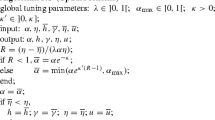Abstract
The method of steepest descent with scaling (affine scaling) applied to the potential functionq logc′x — ∑ n i=1 logx i solves the linear programming problem in polynomial time forq ⩾ n. Ifq = n, then the algorithm terminates in no more than O(n 2 L) iterations; if q ⩾ n +\(\sqrt n \) withq = O(n) then it takes no more than O(nL) iterations. A modified algorithm using rank-1 updates for matrix inversions achieves respectively O(n 4 L) and O(n 3.5 L) arithmetic computions.
Similar content being viewed by others
References
D. Bayer and J.C. Lagarias, “The non-linear geometry of linear programming, I. Affine and projective scaling trajectories, II. Legendre transform coordinates, III. Central trajectories,” Preprints, AT&T Bell Laboratories (Murray Hill, NJ, 1986).
C. Gonzaga, “An algorithm for solving linear programming problems in O(n 3 L) operations,” in: N. Megiddo, ed.,Progress in Mathematical Programming: Interior-Point and Related Methods (Springer, New York, 1988) pp. 1–28.
C. Gonzaga, “Conical projection algorithms for linear programming,”Mathematical Programming 43 (1989) 151–173.
N. Karmarkar, “A new polynomial time algorithm for linear programming,”Combinatorica 4 (1984) 373–395.
M. Kojima, S. Mizuno and A. Yoshise, “A primal—dual interior point method for linear programming,” in: N. Megiddo, ed.,Progress in Mathematical Programming: Interior-Point and Related Methods (Springer, New York, 1988), pp. 29–48.
N. Megiddo, “On the complexity of linear programming,” in: T. Bewley, ed.,Advances in Economic Theory (Cambridge University Press, Cambridge, 1987) pp. 225–268.
N. Megiddo and M. Shub, “Boundary behaviour of interior point algorithms in linear programming,” Research Report RJ 5319, IBM Thomas J. Watson Research Center (Yorktown Heights, NY, 1986).
R.C. Monteiro and I. Adler, “An O(n 3 L) primal—dual interior point algorithm for linear programming,” Manuscript, Department of Industrial Engineering and Operations Research, University of California (Berkeley, CA, 1987).
J. Renegar, “A polynomial-time algorithm based on Newton's method for linear programming,”Mathematical Programming 40 (1988) 59–94.
M. Todd and B. Burrell, “An extension of Karmarkar's algorithm for linear programming using dual variables,”Algorithmica 1 (1986) 409–424.
M.J. Todd and Y. Ye, “A centered projective algorithm for linear programming,” Technical Report 763, School of Operations Research and Industrial Engineering, Cornell University (Ithaca, NY, 1987).
Pravin M. Vaidya, “An algorithm for linear programming which requires O(((m+n)n 2+(m+n) 1.5 n)L) arithmetic operations,” Preprint, AT&T Bell Laboratories (Murray Hill, NJ, 1987).
Author information
Authors and Affiliations
Rights and permissions
About this article
Cite this article
Gonzaga, C.C. Polynomial affine algorithms for linear programming. Mathematical Programming 49, 7–21 (1990). https://doi.org/10.1007/BF01588776
Received:
Revised:
Issue Date:
DOI: https://doi.org/10.1007/BF01588776




